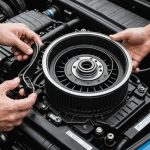As drivers, you’re likely aware of the importance of regular vehicle maintenance. Among the essential maintenance tasks is wheel alignment. But do you know about the most accurate method to test the alignment of wheels in a UK-made car? Today, we delve into the importance of wheel alignment and its testing methodologies.
Wheel Alignment Explained
Before we delve into the topic, it’s important to understand what wheel alignment is and why it’s necessary.
In parallel : Which antifreeze is best suited for winter in a British diesel truck?
Wheel alignment, also known as tracking, refers to the process of adjusting the angles of a vehicle’s wheels to the car manufacturer’s specifications. The objective is to ensure the wheels are parallel to each other and perpendicular to the ground, thereby optimizing the vehicle’s performance.
Wheel alignment is crucial for vehicle safety and efficiency. Misaligned wheels can lead to a multitude of issues, such as irregular tyre wear, reduced fuel efficiency, and compromised steering and suspension. Therefore, it’s crucial to regularly check wheel alignment and correct any discrepancies to maintain your car’s optimal performance.
Also to read : How can you customize the boot space of a British SUV for maximum storage efficiency?
Traditional Methods of Wheel Alignment
In the past, wheel alignment was a relatively straightforward process. Mechanics used simple tools like a string box or bubble balance to check if the wheels were aligned. However, these traditional methods, while effective to a degree, lacked precision and could lead to inaccuracies.
The string box method, for instance, involved aligning a string to the centerline of the wheel and car, which can be highly subjective and error-prone. The bubble balance method, on the other hand, used a level placed on the wheel to check alignment, but this method was also prone to human error.
Modern Methods of Wheel Alignment
Fast-forward to today, and the process of checking wheel alignment has become much more sophisticated and precise. With advancements in technology, modern wheel alignment methods now utilize computerized systems and high-tech machinery to provide a precise, comprehensive alignment check. These advanced systems measure alignment angles with extreme precision, leading to much more accurate results.
One of the most commonly used methods today is the Computerized Alignment. This method uses a combination of lasers and computer software to determine the alignment of the wheels.
During a computerized alignment, sensors are attached to each wheel of the vehicle. These sensors measure the angles of the wheels and the data is then fed into a computer. The computer software compares this data to the manufacturer’s specifications and indicates any discrepancies.
3D Wheel Alignment: The Most Accurate Method
While the above method provide accurate results, the most accurate method to test the alignment of wheels in a car today is the 3D Wheel Alignment.
This cutting-edge technique uses high-resolution imaging technology to create a three-dimensional model of the vehicle’s alignment. This model provides technicians with a comprehensive view of the vehicle’s alignment, allowing for more precise adjustments.
During a 3D wheel alignment, cameras are placed around the vehicle to capture images of the alignment targets that are attached to the wheels. The software then processes these images to identify any misalignments.
What sets the 3D wheel alignment apart from other methods is its advanced imaging technology. This technology allows for a more in-depth analysis, providing technicians with more information about the vehicle’s alignment than ever before. As such, 3D wheel alignment is considered the most accurate method for testing wheel alignment in UK-made cars.
Regular Wheel Alignment Checks: A Necessity
By now, you may have understood the importance of regular wheel alignment checks and the methods used in the process. Irrespective of the alignment method used, it is essential to incorporate regular alignment checks into your vehicle maintenance routine.
Misaligned wheels not only affect the safety of your vehicle but also its performance and fuel efficiency. Regular wheel alignment checks can help identify any issues early and rectify them before they escalate into expensive repairs or, worse, accidents.
Remember, although the 3D wheel alignment provides the most accurate results, the other methods are also effective when performed by an experienced technician. Ultimately, the best method for you will depend on your individual requirements and the specific make and model of your car.
The Benefits of Regular Wheel Alignment Checks
Understanding the importance of wheel alignment checks is crucial for maintaining the longevity of your vehicle. Regular wheel alignment not only improves drivability but also increases fuel efficiency and prolongs the life of your tyres.
Over time, normal wear and tear from driving can cause your vehicle’s wheel alignment to fall out of manufacturer’s specifications. Common factors contributing to misalignment include hitting potholes, bumping a curb, or regular wear and tear. Misalignment, however small, can lead to larger issues down the line, such as uneven tyre wear and reduced fuel efficiency, eventually leading to higher maintenance costs and reduced vehicle life.
Regular wheel alignment checks can help catch these issues early before they escalate. An alignment check will look for three main things – camber, toe, and caster. Camber is the inward or outward angle of the tyre when viewed from the front. Toe refers to the extent to which the tyres turn inward or outward when viewed from above. Caster, on the other hand, is the angle of your steering axis when viewed from the side. All three factors play a crucial role in how your vehicle handles on the road.
Conclusion: Wheel Alignment in UK-Made Cars – A Priority
The importance of regular wheel alignment checks cannot be overstated. Whether you’re driving in the city or on the open road, correct wheel alignment aids in safer, smoother driving, improved fuel efficiency, and a longer lifespan for your vehicle.
While traditional methods of wheel alignment like the string box or bubble balance are still in use today, technological advancements have made way for more accurate methods. The Computerized Alignment and the 3D Wheel Alignment stand as the most precise methods available today, with the latter being the most accurate tool for testing wheel alignment in UK-made cars.
However, remember that the effectiveness of any method is as good as the technician performing it. It is always recommended that you get your wheel alignment checked and adjusted by a certified professional who is familiar with your specific car model and its manufacturer’s specifications. By doing so, you can ensure that your vehicle stays in tip-top condition, delivers optimal performance, and lasts longer.
In conclusion, regular wheel alignment checks are an essential part of maintaining your vehicle’s health. So, don’t disregard it; keep your wheels aligned and enjoy a smoother, safer drive.













